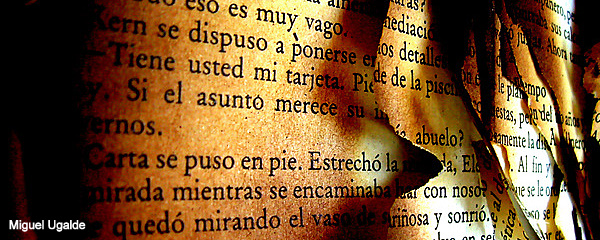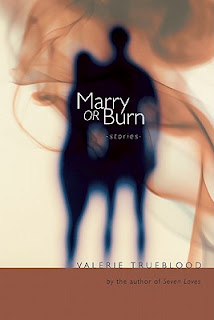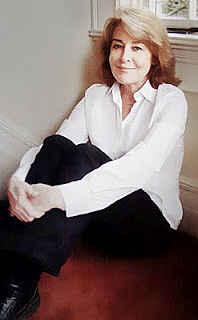
photo by Miguel Ugalde
When I was asked to interview American author Valerie Trueblood at the 2011 Cork International Short Story Festival, where her début collection Marry or Burn was shortlisted for the Frank O’Connor Award, I was delighted to read her work in preparation. I read her shortlisted collection and her novel-in-stories, Seven Loves, as well as her wonderful essay ‘What’s the Story? Aspects of the Form’ – a must read for anyone interested in short fiction. In the essay she rues the eternal question to short story writers: ‘Do you think you’re ready for a full-length work now?’
As to her fiction, Marry or Burn is an intricate and true collection, full of humanity and insight, with twelve bittersweet tales of love gone, or going, wrong. Her novel Seven Loves looks at various stages in the life of May Nilsson, by showing us those she loved and lost, and the loves that endured. What I learnt from reading her work is that Trueblood has the layering skills of Lorrie Moore, the learnedness of Deborah Eisenberg and a wit that is wholly her own. She has deservedly received the praise of Elizabeth Strout, author of Olive Kitteridge, and earned comparison to Alice Munro.
The title called the book into being…
We touched on many things during the course of the interview and Trueblood’s answers were both interesting and enlightening. I started with beginnings because her stories all have arresting openings, such as this: ‘When she was twenty Francie Madden shot and killed her husband Gary’ (Amends); ‘Our father married a woman who took an ax to a bear’ (Beloved, You Looked into Space); ‘Stark Bonney was listening to a patient’s heart when the woman took his hand in hers and placed it, stethoscope still in the palm, on her breast’ (Trespass). I asked whether story openings arrived fully formed to her. Trueblood said that her starting point is usually vaguer than that; it can be a scene, or something heard, maybe in a song. ‘They just kind of pop up,’ she said. ‘I’m glad they appear; sometimes they may seem like gimmicks but I hope that overall they don’t, because they’re not. A scene will demand to be written; I’ll be writing the scene and then the opening will come to me.’
 The title of the collection Marry or Burn comes from the Bible: it is better to marry than to burn with passion. In another interview, Trueblood said that ‘The title called the book into being.’ The stories in the collection look at marriage in lots of different forms – new, old, failed – so they are linked by subject, though they are totally diverse. Into these marriage scenarios, Trueblood introduces what initially seem to be minor players but who, we later see, are actually pivotal. There is often one main character and then a cast of supporters who arrive fully formed with just a few clues. Sometimes we don’t even get to hear these characters speak, like Marcus, the eventual husband in the story ‘Suitors’.
The title of the collection Marry or Burn comes from the Bible: it is better to marry than to burn with passion. In another interview, Trueblood said that ‘The title called the book into being.’ The stories in the collection look at marriage in lots of different forms – new, old, failed – so they are linked by subject, though they are totally diverse. Into these marriage scenarios, Trueblood introduces what initially seem to be minor players but who, we later see, are actually pivotal. There is often one main character and then a cast of supporters who arrive fully formed with just a few clues. Sometimes we don’t even get to hear these characters speak, like Marcus, the eventual husband in the story ‘Suitors’.
Marcus is one of three men that Meg meets via a dating agency; their first encounter is deftly described but all of Marcus’s speech is reported and we get the feeling that he is a sad loner whom Meg will pass by: ‘His standing there in the half-light cast not by candles but by a computer left on in the dining room. He was lonely. Lonely and dejected…At first he was unable to enter into conversation. Now and then he would dive deep and come up with a sentence in his teeth…’ Meg marries one of the other suitors but after he dies, she ends up with the loner, Marcus.
When I asked the author about this specific skill she has regarding minor players who later become important, her response was this: ‘The minor players become our husbands and wives; they’re the people that sue us or pull us out of a flood. In stories, we’ll give the minor characters the germ that kills someone – they get the centre spot. For example, in Oscar Wilde’s story “The Selfish Giant”, the minor player is Jesus Christ. Minor characters come forward in life and so I like to see them come out in a story. They’re no longer minor. They’re everywhere.’
A related skill is Trueblood’s ability to drop in seemingly tangential issues which the reader later learns are crucial. In the story ‘Beloved, You Looked into Space’, for example, we meet a bear. There is a lot of weaving of personality and place and even professions around that bear. The narrator’s widowed father – a vet – suddenly marries Gerda who ‘took an ax to a bear’ to save her first husband:
The first blow she struck was a true one, splitting the ear and causing the bear to drag its head off her husband, then turn a blood-filled eye on her, and stand up. The head swung, a paw swiped her arm and knocked her down. But the bear dropped back to her husband…She felt for the ax, got to her feet. Like a batter, she swung it into the neck.
The injured bear gives up the attack and walks off, and the husband dies. Later, the narrator’s father posits that Gerda had ‘met the wrong bear, the one most mercilessly wrong.’ The bear becomes a motif for Gerda and the danger she may introduce into the vet’s life: ‘…was there something about her blemished, touched with animal breath?’
In her essay What’s the Story? Trueblood asserts that ‘the best stories are saturated to the point where everything in them partakes of and refers to everything else.’ When I asked her about this, she spoke specifically about the bear in her story: ‘The bear is already a bear to me because every year my husband and son go out into the back country to hike, and I stay at home to learn everything there is about bears. The bear is like the being of a short story. The part you can’t put your finger on that’s at the centre of the story. The bear acts as that; it’s not a symbol – I don’t believe things should symbolise each other – but a crux. A way the grief of the characters can be shown. In a short story, anything is possible; a tree can come to stand for the whole story.’
There is a kind of subdued glee in much of Trueblood’s fiction. I asked her how important humour is to her writing, and where it emerges from. She said it’s very important to her: ‘I think of myself as someone who has a tragic view of life – and I think I do have this tragic view – but I also have this childish desire to make fun of it. The wish to laugh at life goes with the tragic…one protection against tragedy is when everything can dissolve – it’s like the humour people need at a wake.’
One thing I am always interested in is the writer’s relationship with self-editing. All of the stories in Trueblood’s collection are long (the shortest is over 4,000 words; the longest over 12,000). As a writer who struggles to write long stories, I am fascinated by the length and I asked her if they took a long time to write.
‘They do take a long time,’ she said, ‘and my problem is I go back to them forever and continue to edit them again and again – I wish I could edit them when they come out but I can’t. When I write a fifty- page story and cut it to a thirty- page story, I realise I’ve cut it to the bone and I wish I hadn’t published it originally as it was in its longer form.’
The limitation of the short story is part of its greatness…
We talked further about the technical issues that stories can pose and also about temporal issues. In Trueblood’s story

‘Amends’, Francie talks about how time passes in prison: ‘Time brought nothing to a noticeable close. Nothing drew its edges together or untangled itself…It was not a road heading somewhere but a space that filled up, like a vacuum cleaner bag.’ This struck me as a metaphor for how the short story works; I asked Trueblood if she agreed.
‘All stories have technical problems and I don’t think anyone is ever ready to let them go…you want a story to be one thing and then it turns into something else and then there’s such a feeling of regret. The short story has a saturation point that the novel doesn’t have – like a vacuum cleaner bag – you have to realise when you reach it. The limitation of the short story is part of its greatness. We don’t have to observe unities in a short story; it can cover a lifetime or a day – the time in a short story can be long but some magical limiting factor has to work on it.’
I corresponded with Trueblood before our interview and in one of her emails she mentioned the ‘mental thrill’ in the short story that is found in no other form. I asked her to talk about what that meant to her as writer and reader, and also how she aimed for it in her fiction. She answered: ‘I don’t know how you aim for it but as a writer you always hope for it and you recognise it in the things you read. The short story has more of this thrill than a novel – it’s not a contest but in some ways I see it as that… in a short story, you’re not heading towards the resolution or the clue you saw in the opening section; it’s like going on a ferris wheel. It’s going to turn, you’re not going anywhere but something is going to happen to you. It’s a circle; it contains a thrill that a trip down a road or a trip down forty chapters doesn’t have; it’s the thrill of your feet leaving the earth. It’s the experience of knowing that there’s something in store for you. It can never be a poem – but it aims for the same thrill.’
From our correspondence, I knew that research was important to Trueblood. While writing ‘The Magic Pebble’ she read several books about Lourdes in France, even though the character never actually arrives there – she is still on the aeroplane as the story ends. In one email, Trueblood discussed the background reading she did and how ‘Stories of the visited – the Fatima story, the fifteen enthralled at Knock – have always interested me.’
She also read extensively about bear maulings for the story ‘Beloved, You Looked into Space’. ‘The internet has almost been the death of me,’ she said. ‘I’m infected with a love of tracking things down; not to explain them but just to know about them. But as writers, we do all this work and then it doesn’t fit anywhere; we sort of know things and then it doesn’t fit into the story. You absorb bits into the story but then it becomes all about the story. Research is very vaporous in my mind; it doesn’t come to any fruition but it’s a kind of fiendish enjoyment.’
…a slowed down, dawning truth…
In What’s the Story?, Trueblood says the short story should offer ‘a slowed down, dawning truth’ to the reader and that no conclusion or even an outcome is required. I asked her if this may be the reason some readers resist stories, or find them ‘hard’ or ‘unsatisfying’. Trueblood’s exasperation with the general reader’s lack of love for the short story was obvious: ‘Don’t they like beauty? Don’t they like butter? What is wrong? I think in the States it’s the longing for a solution to everything and the inability to accept the absence of that in the short story. It’s the result of our history and Hollywood.’
I asked if she thought there was any way of getting the reading public to want story collections the way they want novels. ‘I think,’ she said, ‘we just have to give people collections and anthologies. Talk about, write about and share them. It must be this lack of outcome in the modern short story that’s the problem; older short stories used to have a resolution. I think people who have this resistance don’t know what the form is – but how do you introduce people to this form? Make them perceive it as more than just a shortened thing? I don’t know. Publish more of them. Some people say “When are you going to do a full length work?” What is this “full length” people talk about? I don’t know!’
Colm Tóibín once wrote that ‘[In the short story] we can offer merely small instances un-associated with other instances…A short story is pure and simple, like a sacrament.’ This chimes with Trueblood’s belief that stories are ‘extracts’ that promise to show the reader a secret which, in What’s the Story?, she explains ‘has to do with the nature and the whole of life’. I asked what kind of secrets were revealed in the stories in Marry or Burn.
‘The short story really is about the nature of life, and it tackles subjects which the novel can’t tackle as well. For instance, death; a novel can’t go on for 500 pages about death. I do think at the end of the story, you should have some feeling you didn’t go into the story with. It’s not like in a novel where you go back and find out the hidden secret; I don’t think in a short story you can summarise it. You apprehend it and learn it but it’s still secret. The secret is an illumination which you can’t convey except by giving someone the story to read.’
I am recommending Valerie Trueblood to you now but, as you have seen, with her insights and knowledge she is a writer who very much recommends herself.
~
NB: On Wednesday, THRESHOLDS will be publishing a new short story by Valerie Trueblood.

